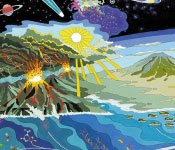
Although the physical environment that fostered primitive cellular life is still largely unconstrained, we can be reasonably confident that liquid water was required, together with a source of organic compounds and energy to drive polymerization reactions. There must also have been a process by which the compounds were sufficiently concentrated to undergo physical and chemical interactions. Our laboratory is exploring self-assembly processes and polymerization reactions of organic compounds in natural geothermal environments and related laboratory simulations. We have found that RNA-like polymers can be synthesized non-enzymatically from ordered arrays of mononucleotides in lipid microenvironments. Chemical activation of the mononucleotides is not required. Instead, synthesis of phosphodiester bonds is driven by the chemical potential of fluctuating anhydrous and hydrated conditions, with heat providing activation energy during dehydration. In the final hydration step, the RNA is encapsulated within lipid vesicles. The reaction has been shown to occur not only in a laboratory setting, but also on mineral surfaces of a hydrothermal volcanic site on Mt. Lassen. We are now extending this approach to template-directed synthesis of RNA, in which lipid-assisted polymerization serves as a model of an early stage of evolution toward an RNA World.
 Getting Under Europa’s Skin
Getting Under Europa’s Skin Tracing Formation and Evolution of Outer Solar System Bodies Through Stable Isotopes and Noble Gas Abundances
Tracing Formation and Evolution of Outer Solar System Bodies Through Stable Isotopes and Noble Gas Abundances Photosynthesis, a Planetary Revolution
Photosynthesis, a Planetary Revolution Xenon: King of the Gases
Xenon: King of the Gases